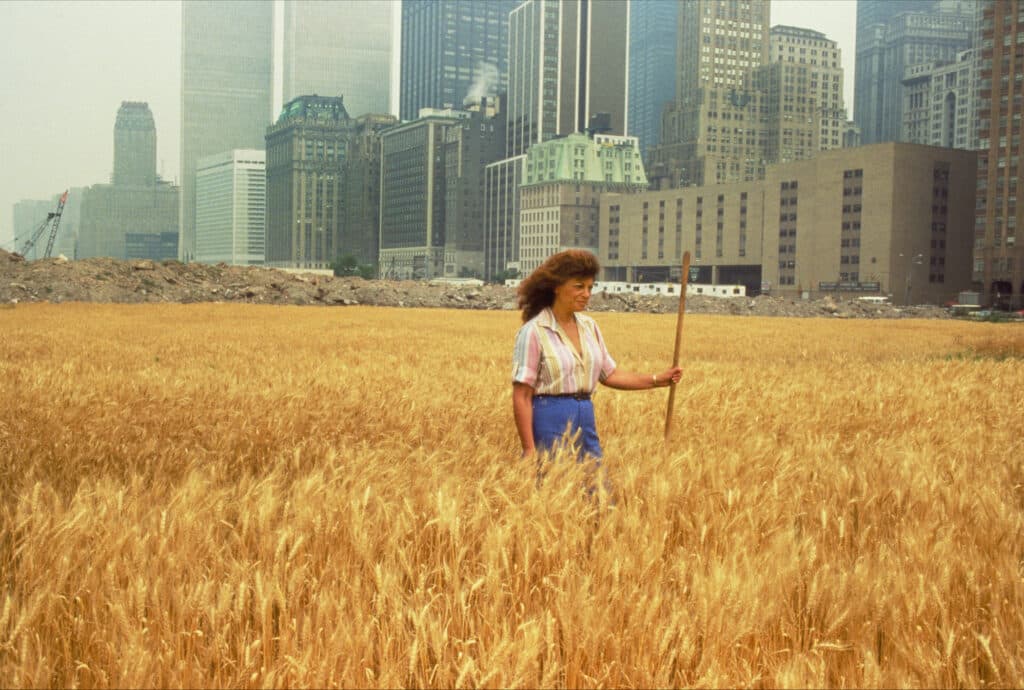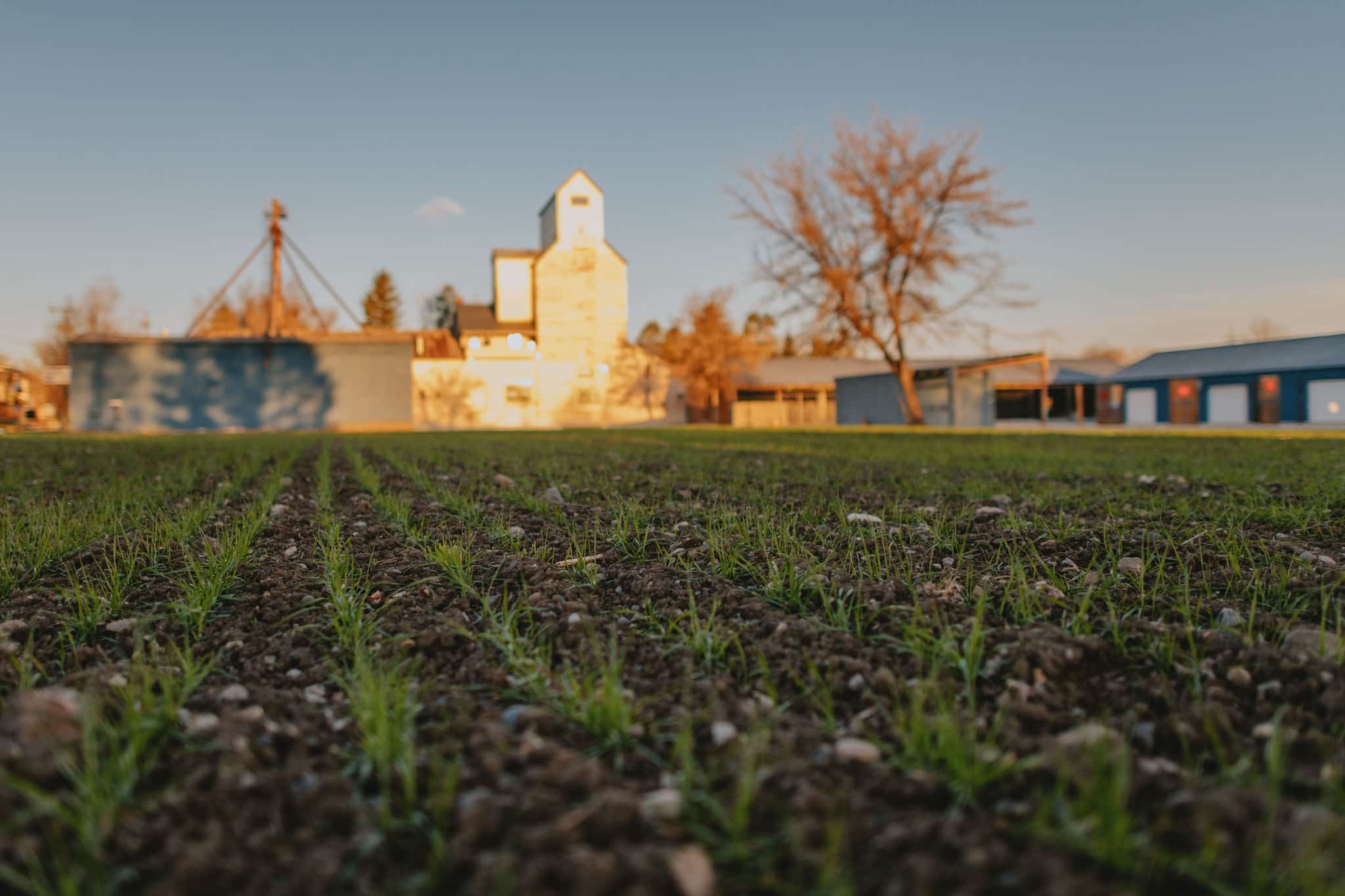Many Montanans have experienced standing in a wheatfield, running their hands over the tops of the golden stalks, and letting the spiky, hair-like awns tickle their palms. But imagine, as you look up and let your eye follow the wind rippling across the grain towards the horizon, if, instead of seeing rolling foothills, your eye is halted by an imposing wall of skyscrapers.
Forty-two years ago, Hungarian-born, New York-based artist Agnes Denes brought such imagery into reality. In the spring of 1982, in the landfill left in the wake of the recently built World Trade Centers, Agnes was inspired to plant a two-acre wheat field. Over the next few months, the project grew into the germinal ecological art installation Agnes would call Wheatfield – A Confrontation. The installation, though only around for one brief growing season, left an indelible mark on the psyche of the city’s art community and led to the iconic photographs of the artist standing in a shimmering autumn wheat field amidst a backdrop of stately high rises, smack in the heart of the Manhattan financial district.
The piece, for Agnes, was meant to be precisely that: a confrontation. To confront and challenge her fellow New Yorkers’ minds with questions about land: its uses, how we value it, the inherency of those values, and whether or not we should re-evaluate them. It also opened the opportunity to examine other related tangents, such as land development, loss of agricultural and natural landscapes, food insecurity, increasing global population, and what we want our environments – the spaces we are surrounded by daily – to consist of.
So when Jenny Moore, the director of Tinworks Art in Bozeman, who has worked in unique and prestigious art spaces around the world, including the Guggenheim in New York, was pondering the best use of space that could center art in the lot of land on the corner of Tinworks’ home on North Ida, her mind automatically went to Agnes’ iconic Wheatfield.
Jenny, who was recruited from her last position as Director of The Chinati Foundation in Marfa, Texas – an unconventional art museum on an old military base comprising 34 buildings on 340 acres – became Tinworks’ inaugural director in March 2023. As Jenny became increasingly familiar with her new home in the Gallatin Valley, Agnes’ Wheatfield project gained even more meaning for the Texas transplant. Wheat is an iconic aspect of Montana, carrying historical, agricultural, and economic significance. Additionally, agricultural land loss due to development is rising throughout the state, nowhere more so than in Gallatin Valley. As Jenny put it, “Bozeman is in a dynamic moment of change, currently poised in a juxtaposition between rural and quasi-urban, on the cusp of transitioning from what was once a primarily rural farming community to a burgeoning micropolis.”

Jenny contacted Agnes and proposed recreating Wheatfield. To Jenny’s delight, Agnes agreed. Now 92 years old, this is the first time Agnes has accepted the invitation to reimagine Wheatfield in the United States and the first time the work will be positioned in the West.
While Agnes agreed to revive her work, including paying homage to the original, she also views this piece as distinct, a sentiment reflected in how she markedly contrasted the titles. Where the original is titled Wheatfield – A Confrontation, the current piece at Tinworks Art is Wheatfield – An Inspiration. The seed is in the ground.
The new title reveals the inspiration that was ignited in Agnes through her journey into the Bozeman project. Agnes has reinvisioned the piece with a new level of community engagement, inviting Bozeman residents to become part of the artwork by planting their own patch of wheat in solidarity with Wheatfield in any fallow piece of ground throughout the city, whether in
their backyard, around their mailbox, or even along an alleyway.
In the fall, people can harvest the wheat and bring it to Tinworks, which will have several small-scale mills onsite to process. Wild Crumb, an artisan bakery in the neighborhood, has partnered with the project to use the flour from the wheat to bake bread and other baked goods for purchase, with loaves also redistributed back into the community through the local food bank.
In addition to residential participation, the project has already brought together many other collaborators. Bozeman-based SIME Construction came in with excavators, haul trucks, and bulldozers to remove rock and gravel piles and level the ground. Members from Montana State University’s soil testing labs tested the soil and found it excellent, which, according to Jenny, wasn’t surprising to Kenny VanDyke, the local farmer who planted the wheat and helped educate her on just how good the agricultural land in the Gallatin Valley is.

Photo: John McGrail, courtesy Agnes Denes and Leslie Tonkonow Artworks + Projects
“I always think it’s amazing the places art can take us,” said Jenny. “In this case, I’ve had the opportunity to learn about the incredible history of wheat in Montana… [and] I’ve certainly been inspiredto have conversations I’ve never had the chance to have before, about agriculture, and a whole host of other issues.”
Kenny — who, along with his older brother, farms 7,000 acres across Montana, including 2,000 in the Bozeman area — has been instrumental in this project and is a living example of the type of considerations Agnes’ original Wheatfield posed to viewers about land use, most of which are still relevant today.
The VanDyke brothers, fourth generation Montanans born and raised in Bozeman who, despite being raised on a dairy farm turned cattle ranch, consider themselves first generation grain farmers, are willing to try just about anything once to “make it work.” Starting in 2011 as conservation farmers practicing no-till farming to conserve topsoil and water retention, the brothers have recently moved towards regenerative practices to improve soil nutrients and reduce reliance on costly chemicals and fertilizers.
Despite these efforts, the increasing development of agricultural land around Bozeman has added significant challenges to Kenny’s ability to farm the area. Not least is land ownership, which — although always a challenge for beginning farmers — is
incredibly prohibitive in Bozeman’s current market. Development even affects the more common alternative of land leases. Fewer and fewer landowners want to tie up their land in leases in case they decide to sell, leaving farmers in the area to increasingly rely on “handshake” deals that can fall through at the last minute. Kenny has gained and lost 800 acres in a year, with landowners calling him in the spring after he’s bought all the seed to tell him not to plant because the land has sold.
Yet another challenge comes from waning infrastructure, which is indirectly influenced by development. Several years ago, a grain elevator burned down and was never replaced. “No company is going to spend millions of dollars to
build an elevator in a valley that’s losing farmland at an alarming rate,” states Kenny. A similar thing happened regarding a fertilizer plant recently as well, where the aging plant needed an entire rehaul, yet rather than rebuilding in a waning farm community, the company opted to simply sell; yet another “slice” in what feels like death by a 1,000 cuts.

“It’s one of those things where we joke, ‘You either got to change locations or change professions!’” says Kenny, who foresees eventually having to take his small family and leave the area to join his brother farming up north along the Montana Hi-Line. The notion is not without a bit of nostalgia for the Bozeman native.
“We have some gorgeous places, some beautiful properties in Bozeman, you know, down in the trees by the river, that we farm,” says Kenny. “…The thought of leaving is pretty hard.”
While Kenny sees the trend of losing ag land to development as somewhat inevitable and sympathizes with anyone who chooses to sell in such a market, he has witnessed examples of the alternative. Some landowners — ones, according to Kenny, who may be in a financial position to value having the land over the money it’s worth — have opted not to sell. Others have found ways to stay afloat, including long-term leases with farmers who can guarantee a more minor but steadier income
stream for the next 30 years.
According to Brendan Weiner, Conservation Director of Gallatin Valley Land Trust, landowners choosing to protect their land in conservation easements is also becoming increasingly popular. The organization has seen an uptick in landowners opting for that route in the last decade, especially as more people are beginning to see and contemplate that the very things that brought them to the valley — like wide-open spaces, acres of agricultural land, and beautiful natural landscapes — are precisely what’s at stake. “I have the utmost respect for some of these people that do keep it ag,” says Kenny, “And
I think it’s good for people to have some awareness about [these issues].”
Agnes and Tinworks Art are clear that Wheatfield–An Inspiration. The seed is in the ground is an invitation for us all to consider where we are today, where we’re headed, and, possibly, reimagine and redirect our trajectory. The seeds of change are in the ground!
HOW TO PARTICIPATE:
- Plant wheat in solidarity in any fallow land.
- Help tend Wheatfield in the summer and fall of 2024.
- Reconsider the value of land in your community. Visit tinworksart.org for more information.
FIND MORE STORIES LIKE THIS ONE IN OUR LOCAL FOOD GUIDE!
Written By:
Teresa Byrd
